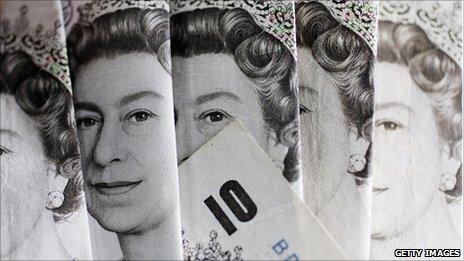How much forged money is in circulation in the UK?
- Published

Real or fake? Britain's notes contain a variety of security features but forgers still try to make the perfect copy
The history of counterfeit money is almost as old as currency itself, and despite the use of the most sophisticated modern technology, the battle persists today between the banks and the fraudsters.
It is not difficult to see the watermark, hologram and metal thread inside banknotes.
But visit De La Rue, the company that prints banknotes for the UK and 150 other countries and you will discover a wealth of other, hidden security features.
Whereas most graphic print uses just one printing process, sterling banknotes are made with three.
Run your fingernail across the number ten in the top right corner, and you'll feel how bumpy the surface is. The tactile intaglio print deposits the ink in recesses in the paper surface also giving the banknote its crisp, shiny quality.
"It's a high pressure printing process so where there's no type you get a smoothing of the paper, which also means the note doesn't accept dirt so easily," says Paul Howland, head of paper science at De La Rue.
Behind Darwin's head, the pastel blues, greens and oranges are not made up of dots of colour, like most graphics, but instead are made up of tiny lines as a result of the offset printing technique used.
There is also microprint hidden inside the images. A magnifying glass will reveal the word "ten" printed inside the Queen's pearls.
Forged notes
But at London's Church Street market, stallholders still have to keep their eyes peeled for fakes.
"You get spates of them, every now and again," a fruit and veg seller said. "Everyone will get one or two."
Skimming the top edge of the intaglio print will often tell stallholders whether the note is a fake, but some even pass this test: "If you saw the last lot we had, they were perfect. You couldn't tell by looking at them," he said.
In 2009, Bank of England figures revealed 566,000 counterfeit notes in the UK. Of these, 95% were twenty pound notes.
"This has to be set against the number of notes in circulation which is about 2.6bn," says Victoria Cleland, Head of Notes Division - so just one note in every 5,000 was a fake.
"We're still working on the final stats for 2010 but the number was coming down quite dramatically."
The most common fraud is of one pound coins. There are some 30-40 million in circulation, so about 2.8% of the total are fakes.
The Royal Mint works with the Serious Organised Crime Agency to combat counterfeiters.
Twice a year, a random sample of pound coins are taken for analysis from different regions in the country.
"Maybe the crown detail isn't good, or the initials round the edge aren't as precise as they should be," says the Mint's Deputy Master Adam Lawrence.
"Different forgers will also use different metal compositions, and some are quite a long way from the right mix.
"But in some, the composition is reasonably close and the quality of the striking isn't too bad."
When they reach banks, counterfeits are taken out of circulation using sorting machines with multiple sensors which detect the sound, look and feel of banknotes.
New notes sound loud and crisp. The oldest notes are quiet and limp and can also be removed.
Notes are also screened for graffiti and if there is any sticky tape, the machine measures the surface area to determine if the note is too old and tatty to put back into circulation.
Cashless society
A good way of reducing fraud would be to stop using coins and notes altogether according to economist and author John Kay, who thinks that cash breeds crime, from trading stolen goods to drug deals.
"Our whole social and economic lives would be transformed if we didn't have cash. In the long run it would be in government's and banks' interests to move to a cashless society," he said.
"An enormous amount of crime is about getting hold of cash, an enormous amount of expenditure on security is about protecting cash."
But he points out that there would be a lot of costs upfront for governments to switch to a cashless society.
'It's not a vote winner and probably not a customer winner even for a bank. Banks don't have any strong incentive to change and it would reduce the central role of banks in our lives."
And banks also face a battle against fraud in the cashless world of online finance and credit cards with huge amounts of money spent on security measures such as electronic chips and pin codes.
Back at De La Rue, Mr Howland is quietly confident that cash has staying power: "It's been going for 3,000 years so it certainly has a good pedigree.
"I think it's got a good future, but who knows what the future holds."
The Smell of Money will be on Radio 4 at 1100 GMT on Tuesday 1 March 2011 and after on BBC iPlayer
- Published27 July 2010
- Published17 December 2010
- Published17 November 2010